Hokey religions and ancient weapons are no match for a good broadsword at your side, kid. Except for these ancient weapons, which are so gnarly and sadistic you’ll want to incorporate them immediately into your D&D or Pathfinder game.
Weapons From History
[bs_smart_list_pack_start][/bs_smart_list_pack_start]
Haladie
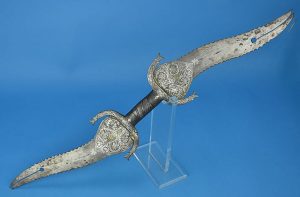 India produced a lot of interesting weapons back in its gnarly weapon heyday, but among the most dangerous was the haladie. The haladie was a weapon of India’s ancient warrior class, the Rajput, who were considered the samurai of India, as they lived a lifestyle dedicated to fighting and honor.
India produced a lot of interesting weapons back in its gnarly weapon heyday, but among the most dangerous was the haladie. The haladie was a weapon of India’s ancient warrior class, the Rajput, who were considered the samurai of India, as they lived a lifestyle dedicated to fighting and honor.
Haladie had two double-edged blades connected to the ends of a single handle. The slight curve of the blade made it excellent for slashing, thrusting, or parrying. And some haladie had knuckles built into the handle where spikes or an extra blade could be attached, making it triple bladed.
An enemy pitted against an army of haladie-weilding Rajput would be facing a hala way to die.
Urumi
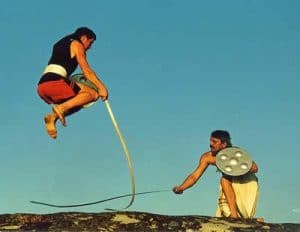 Imagine a 10-foot-long sword “whip” with a metal blade so flexible and bendable that it could be wrapped around a waist and worn like a belt when not in use. That’s a urumi.
Imagine a 10-foot-long sword “whip” with a metal blade so flexible and bendable that it could be wrapped around a waist and worn like a belt when not in use. That’s a urumi.
Originating in what is now Sri Lanka, Urumi could be whipped in circles defensively, creating a defensive zone difficult for an opponent to penetrate. Then when used offensively, it was impossible to parry against a urumi, as it couldn’t even be stopped with a shield, as the urumi would just bend around it to strike.
With both sides of the blade sharpened, urumi were extremely dangerous even for the wielder and required years of training before the warrior was whipped into shape. It couldn’t be used in tight formations obviously, so it became ideal in one-to-one combat and in assassination situations. Even simple things like bringing the weapon to rest were difficult to master, but when proficiency was reached with a urumi it was nearly unstoppable.
The Mancatcher
 There comes a time when everyone has a need to kidnap a nobleman on horseback, and when that time comes, you’ll be thankful you have a mancatcher.
There comes a time when everyone has a need to kidnap a nobleman on horseback, and when that time comes, you’ll be thankful you have a mancatcher.
A mancatcher is a polearm that looks like it came from a Monte Python film and was designed specifically to dismount and secure high value targets on the battlefield, as one does. If the target was well-armored (like a knight) a mancatcher might have spikes to really get his attention, but they all had a spring-loaded collar to trap those necks real good.
Interestingly, the Japanese have a similar weapon that is still in use today as a non-lethal way to apprehend troublemakers and nere-do-wells.
The Naginata
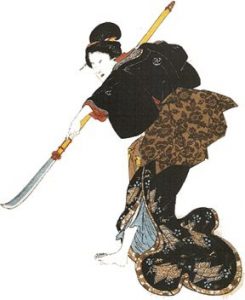 Speaking of polearms and the Japanese, the naginata is a Japanese bladed pole weapon that were originally used by both the samurai class of feudal Japan and the sōhei (warrior monks). Most interestingly, the naginata is the iconic weapon of the onna-bugeisha, a type of female warrior from the Japanese nobility.
Speaking of polearms and the Japanese, the naginata is a Japanese bladed pole weapon that were originally used by both the samurai class of feudal Japan and the sōhei (warrior monks). Most interestingly, the naginata is the iconic weapon of the onna-bugeisha, a type of female warrior from the Japanese nobility.
The Naginata was made from a short, curved blade, but instead of being attached to a normal sword hilt, it was attached to a staff that was up to 4 feet long.
The weapon was extremely useful for defenders, as it’s wielder could both keep sword-carrying attackers out of range, plus keep them honest due to the blade.
The Bagh Naka
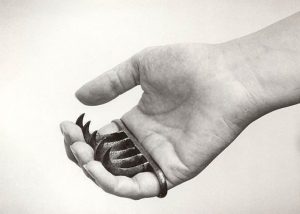 The gnarly-weapon-making Indians aren’t done, as they were Wolverine long before the Weapon X program. The Bagh Naka, an Indian hand-claw, was a favorite among thieves and assassins of the 15th and 16th centuries. The Bagh Naka is literally translated “tiger claw” in Hindi and was indeed inspired by big cats. Functionally, it was a crossbar with four or five sharp blades and two finger-holes for the wearer’s thumb and pinky finger.
The gnarly-weapon-making Indians aren’t done, as they were Wolverine long before the Weapon X program. The Bagh Naka, an Indian hand-claw, was a favorite among thieves and assassins of the 15th and 16th centuries. The Bagh Naka is literally translated “tiger claw” in Hindi and was indeed inspired by big cats. Functionally, it was a crossbar with four or five sharp blades and two finger-holes for the wearer’s thumb and pinky finger.
It could be worn so that the blades extended over the knuckle, of course, turning one’s hand into a tough cat mauling device, or flipped and worn so that the blades are hidden in the palm of the hand, for a more, shall we say, clawing approach.
Some models even had additional blades jutting out from the side just in case you needed to deal 1d4 damage to the guy standing off to your left.
The Macuahuitl
The Macuahuitl was was a common weapon used by the Aztecs and Mayans of central Mexico. It was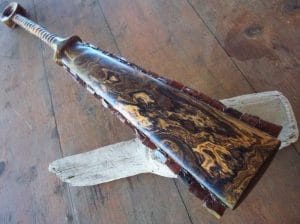 a baton with numerous obsidian blades around its sides like scales. It could be used to lacerate opponents or bludgeon them into unconsciousness.
a baton with numerous obsidian blades around its sides like scales. It could be used to lacerate opponents or bludgeon them into unconsciousness.
Beat ’em or cut ’em, take your pick.
The conquistadors shared reports of Macuahuitl being used to decapitate horses with a single swing, so watch yourself. There are sadly no known authentic Macuahuitl left in existence, but there is no reason you couldn’t create one for your D&D campaign.
The Fire Lance
Step 2: Fill a bamboo tube with a mixture of gunpowder and sharp objects.
Step 3: Tie the bamboo tube to the end of your spear.
Step 4: Aim your new weapon at an enemy and light the fuse.
Congratulations, you’ve just made and discharged a Chinese Fire Lance, considered one of the earliest gunpowder weapons. It was invented in the 10th century and was used throughout the Ming dynasty.
While they may have been unpredictable and one-use weapons, fire lances were cheap to make, and very effective at short range, if even to psychologically terrify enemies. They were most often deployed in city defense when invading or marauding armies appeared at the gates. If the shrapnel didn’t get you, you were still dealing with a guy holding a crude flamethrower.
Hold it away from your face and light ’em up.
[bs_smart_list_pack_end][/bs_smart_list_pack_end]


